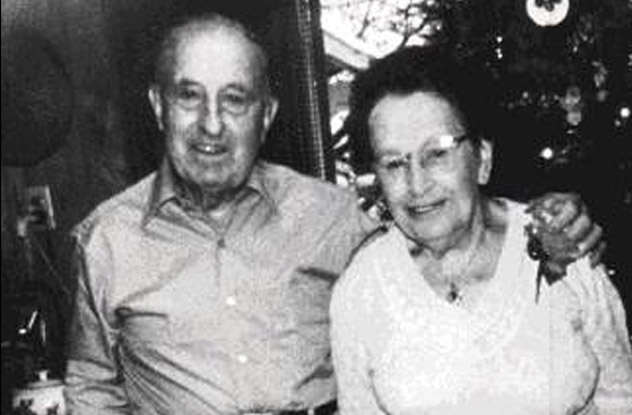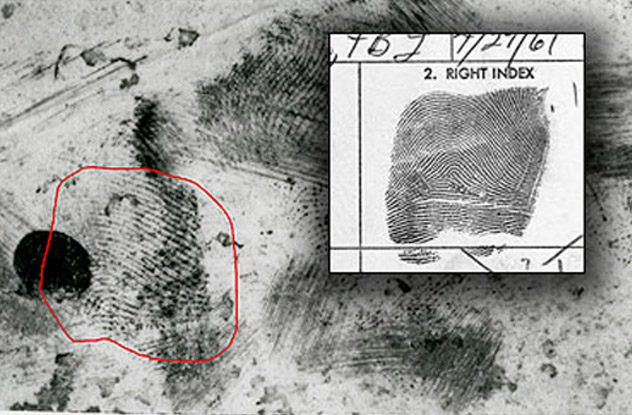10Jessica Lynn KeenSolved After 18 Years
The defrosting of the Jessica Keen case was owed not to one individual or new evidence but to a change in Ohio law nearly two decades after the crime took place. In 1991, Jessica Keen, a high school honor roll student interested in drama and music, was living at a counseling center and home for teens in Columbus. On March 15, she was waiting at a bus stop when she was abducted and taken to a nearby graveyard. Her captors beat her with a 30-kilogram (70 lb) gravestone. Her body was found two days later. The case grew cold until the state passed a law 18 years later forcing all felons convicted of violent crimes to submit DNA samples to a state database. Prisoner Marvin Lee Smith, incarcerated for two other assaults in the Columbus area, gave a sample that matched evidence from the crime scene, and police charged him with the crime. On February 27, 2009, Smith pleaded guilty to the crime and received 30 years to life in a federal penitentiary.
9Cynthia EppsSolved After 20 Years
In June 1994, Buffalo man James Fountain reported that he had found the remains of 29-year-old Cynthia Epps stuffed into a side table in his garage. He said he had no idea how the corpse had gotten in there, and he cooperated fully with the police. An investigation revealed that Epps had recently had sex before being stabbed to death. Her body had been mutilated in an apparent effort to dispose of the remains. She had been almost decapitated. In 2010, Detectives Charles Aronica and Lissa Redmond of the Buffalo Police Department reopened the investigation and looked further into the past of Fountain, now aged 50. By this time, he had numerous rape convictions and a conviction for manslaughter. He had even spent time in the Central New York Psychiatric Center. Police compared his DNA to evidence taken from a rape kit of the 1994 murder. It matched. Fountain pleaded guilty when confronted with the results and was sentenced on July 1, 2013 to 23 years to life in prison.
8Amy WeidnerSolved After 23 Years
Sgt. Bill Carter was a 14-year veteran of the IMPD’s Nuisance and Abatement Unit in 2012, having never worked a homicide case in his career. That changed when a cold case file from 1989 piqued his interest. Amy Weidner, 16, had been found in her Indianapolis home, beaten, raped, and strangled. She had been home babysitting her sick little sister the previous night. The home had also been burgled, with her brother John-Paul’s stereo missing. With no leads but a bloody palm print (virtually useless in the low-tech ’80s), the case collected dust for over two decades. Carter became involved when a colleague asked him to help navigate a memorial page for the victim on Facebook. Once he spoke to the victim’s family and saw that they had all but lost hope, he resolved to uncover the truth behind the brutal murder. A man familiar with the family and the case gave Carter a list of names of people he should talk to. One was Rodney Denk, a friend of John-Paul Weidner, 18 at the time of the crime. Carter obtained his prints the following day after Denk failed to show up to a meeting. They were a perfect match for the bloody handprint left at the scene. Denk was tracked down to a friend’s house on the east side of Indianapolis. Knowing the jig was up, he cut his own wrists. His suicide attempt failed, and Denk was sentenced to 65 years’ hard time for his crimes. Amy’s mother prepared a written statement for the press outside the courthouse the day of his conviction, saying, “I thought I was going to see a monster, but who I saw was Rodney. For 23 years, seven months and one day, we believed a stranger had come into our home.”
7Martha Jean LambertSolved After 25 Years
On November 27, 1985, 12-year-old Martha Jean Lambert went missing near her home in St. Augustine, Florida. The blonde seventh grader was never seen again. With no body, strong evidence, or viable suspects, the St. John’s County Sheriff’s Department were left clueless about the disappearance. The case was shrouded in mystery for the next 25 years, until detectives Sean M. Tice and Howard “Skip” Cole III took one last crack at it. After canvassing Martha’s old neighborhood and speaking to friends and relatives, the detectives took a closer look at the missing girl’s brother David, who was two years older than his sister. Detective Tice skillfully pried out information from David Lambert, now in his late thirties, using a picture of the young girl set on the interview room table as bait. After some 20 hours of questioning, the shocking truth came to light. On that fateful night in 1985, Martha and her brother went to play among the rubble of the Florida Memorial College, which had been abandoned for years, as they often did. David had given Martha money earlier to go to the store, and when she asked him for more money and he declined, she punched him. Getting angry, David pushed his sister, and she fell backward, landing on a protruding metal spike. It impaled the young girl’s skull. Panicking, he buried the body in a shallow grave and kept the secret for over two decades. Given the statute of limitations and other mitigating factors, the police decided not to charge David Lambert. Martha’s remains were never found due to construction in the area, so we’ll never know if David’s story was exactly true.
6Minnie and Edward MaurinSolved After 27 Years
For most, Christmas is a time of goodwill, sharing, and joy. This was not the case for the small town of Chehalis, Washington on Christmas Eve, 1985. Six days earlier, Edward Maurin and his wife Minnie had been reported missing. They were 83 and 81 years old, respectively. Witnesses saw the couple’s car with bloodstains and the keys in the ignition. Less than a week later, their bodies were found in a wooded area outside town, both shot to death. Detectives had two primary suspects for the killings—the Riffe brothers, Rick and John—but lacked probable cause to justify an arrest. Witnesses were scared of repercussions upon testifying against the pair, who were known and feared. It would be nearly 30 years before Washington State prosecutors had enough evidence to secure a conviction. John Riffe died just a week before investigators bought tickets to travel to Alaska to make their arrests. Rick was not so lucky. After a six-week trial, the remaining Riffe brother was found guilty on seven felony counts, including the murders. He was sentenced to 103 years in a federal penitentiary. Over 50 friends and members of the Maurin family turned up to the courthouse for the verdict and sat on the prosecution’s side of the room. The defense’s side was empty, save for Riffe’s legal team.
5Diane Maxwell JacksonSolved After 34 Years
The FBI has a morbid annual tradition called the “Latent Hit of the Year” award, honoring a fingerprint technician who gets a match resulting in a major conviction for a violent crime. The 2011 winner involved a case going all the way back to 1969. At Christmas of that year, young Houston telephone operator Diane Jackson was abducted in the parking lot of her place of work and was raped, strangled, and stabbed to death in a nearby shack. Police found a fingerprint, but with nothing to compare it to, it wasn’t very useful. In 1989, the victim’s brother David, now a Texas Ranger, looked into the case once more. A Houston newspaper asked the public to help with any information. With technology now advanced and a database set up for prints, the latent print from the crime scene was run through the system. None of the local databases came up with a match. Then in July 2003, FBI database technician Jill Kinkade got a hit, just five hours into her search of the 70 million prints on file. Kinkade narrowed it down to 20 potential matches, having a close eye on a favorite: James Ray Davies. Davies was brought in for questioning, and it was found out that he had been released from prison just days prior to Jackson’s murder. On November 24, 2003, over three decades after the death of his sister, David Jackson saw her killer confess to the crime. Davies went to prison for the rest of his natural life.
4Robert Peterson, Anton Schuessler, and John SchuesslerSolved After 40 Years
In October 1955, the naked bodies of three boys—John Schuessler, 13, his brother Anton, 11, and Robert Peterson, 14—were found in the Cook County Forest Preserve. The boys were the victims of sexual assault before they were all strangled and dumped. Thirty-nine years later, in 1994, Kenneth Hansen was arrested and charged after being picked up on suspicion of arson. Hansen wasn’t convicted for the 1955 murder until 1995, when prosecutors contended that the man, 22 at the time, had picked up the three hitchhiking boys and taken them to the stables for his horrendous attack. The story was not over, however. Hansen’s conviction was overturned five years later because certain testimony—statements saying Hansen was gay and frequently cruised the streets in search of young boys—should have been inadmissible. A retrial was held the same year, and after only two hours of deliberations, another jury found him guilty. He was sentenced to 300 years in prison. Hansen died in prison in 2007, although some still doubt the man twice found guilty was the party responsible. The defense even had another man’s confession, but it was ruled inadmissible as evidence.
3Pamela Jackson And Cheryl MillerSolved After 42 Years
The truth is not always as evil as it seems. When Pamela Jackson and Cheryl Miller went missing in 1971 on their way to a party, many feared the worst. But in 2014, water levels at the nearby Brule Creek dropped, revealing their vehicle. Neither foul play nor alcohol had played any role in their deaths. It had simply been a car accident. What’s horrible about this case is that a man innocent of the crimes spent a decade in jail for the murders, all on a falsified confession from a jailhouse snitch. The snitch handed over a tape, allegedly of David Lykken admitting to killing the teenagers, but it didn’t even sound like Lykken’s voice. Lykken was released and is now filing a $400,000 lawsuit against the state.
2Richard Phillips And Milton CurtisSolved After 46 Years
On July 21, 1957, four teenagers were parked in a car on Lovers’ Lane, El Segundo. A man armed with a handgun approached the car, tied up the four, and raped the 15-year-old girl in the front seat. The assailant then stole all the valuables he could get his hands on and took the 1949 Ford, ditching his victims in their underwear at the side of the road. Roughly 90 minutes after these crimes, the perpetrator ran a red light, attracting the attention of two young police officers. Richard Phillips and Milton Curtis, both fresh out of the academy, pulled over the suspicious vehicle. Both were shot at point-blank range as they approached the driver’s door. The Ford then sped off into the darkness with the murderer at the wheel. Not until 2003 did the FBI link fingerprints from the crime to prints Gerald Mason had left during a 1956 robbery. By 2003, Mason had a wife and three kids, ran a business, and seemed like an upstanding citizen. But police raided his home and found further evidence. A bullet scar on his back matched a round the police officers had fired, and his handwriting matched the writing on a gun purchase letter. Mason was given seven years to life and was denied parole in 2009. He never stated what drove him to carry out his cold-blooded crimes.
1Lucy JohnsonSolved After 52 Years
In September 1961, 25-year-old Lucy Johnson, mother of one, was at her home in Surrey, British Colombia. She was not seen the next day. Or the next. Or for the next 52 years. For one reason or another, Lucy was not reported missing until four years later. Obviously, this raised questions, and suspicion fell on her husband Marvin. Police even dug up the husband’s backyard in search of a body, but they found nothing. Decades passed, Marvin died, and there seemed no hope of solving the case. One person who never gave up hope, however, was Lucy’s daughter Linda, a small child at the time of her mother’s vanishing. With the help of the Surrey RCMP, Linda posted ads in newspapers and other media outlets in search of clues. Then in 2013, she received a phone call. The woman on the other end of the line claimed to be Linda’s stepsister, whom she’d never known existed. The woman said their mother Lucy was alive and well, living with a whole new family in the Yukon. However unbelievable the claim sounded, Linda followed up it. Sure enough, her mother was not the victim of foul play as suspected. She’d simply fled to another life. Marvin had abused her, claimed Lucy, and when she’d tried to leave with her daughter, he’d stopped her. So she just took off on her own. When Linda visited the caller to check whether the woman in question was indeed her Laura, she recognized her mother immediately. Andrew M. is an Irish author, whose novel The Rain That Fell On Eden should be in a bookstore near you in the not-too-distant future. He also runs a satirical news page on Facebook entitled Utterpishandbollocks. In his spare time he drinks tea and collects waistcoats because they’re awesome.
























